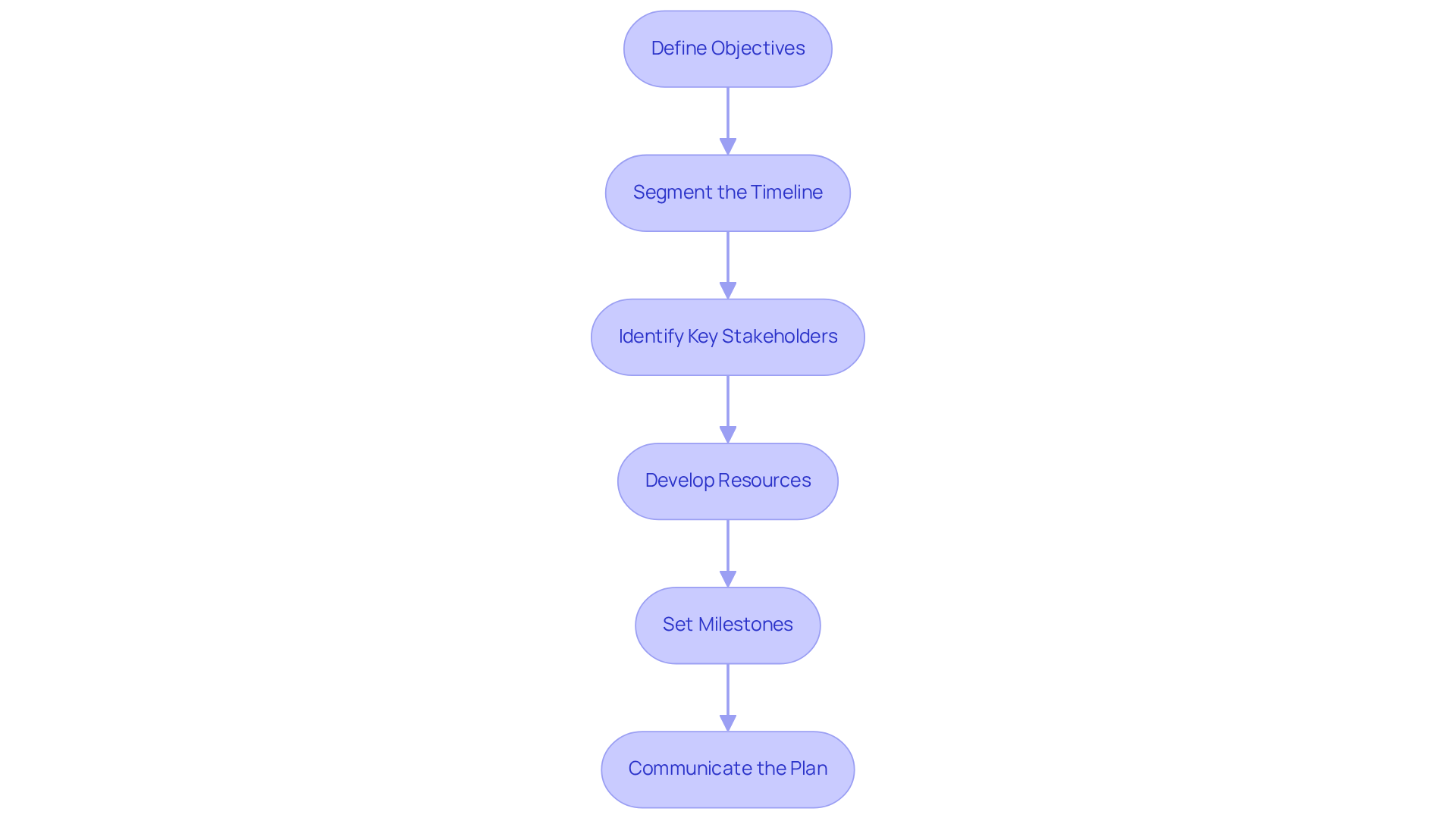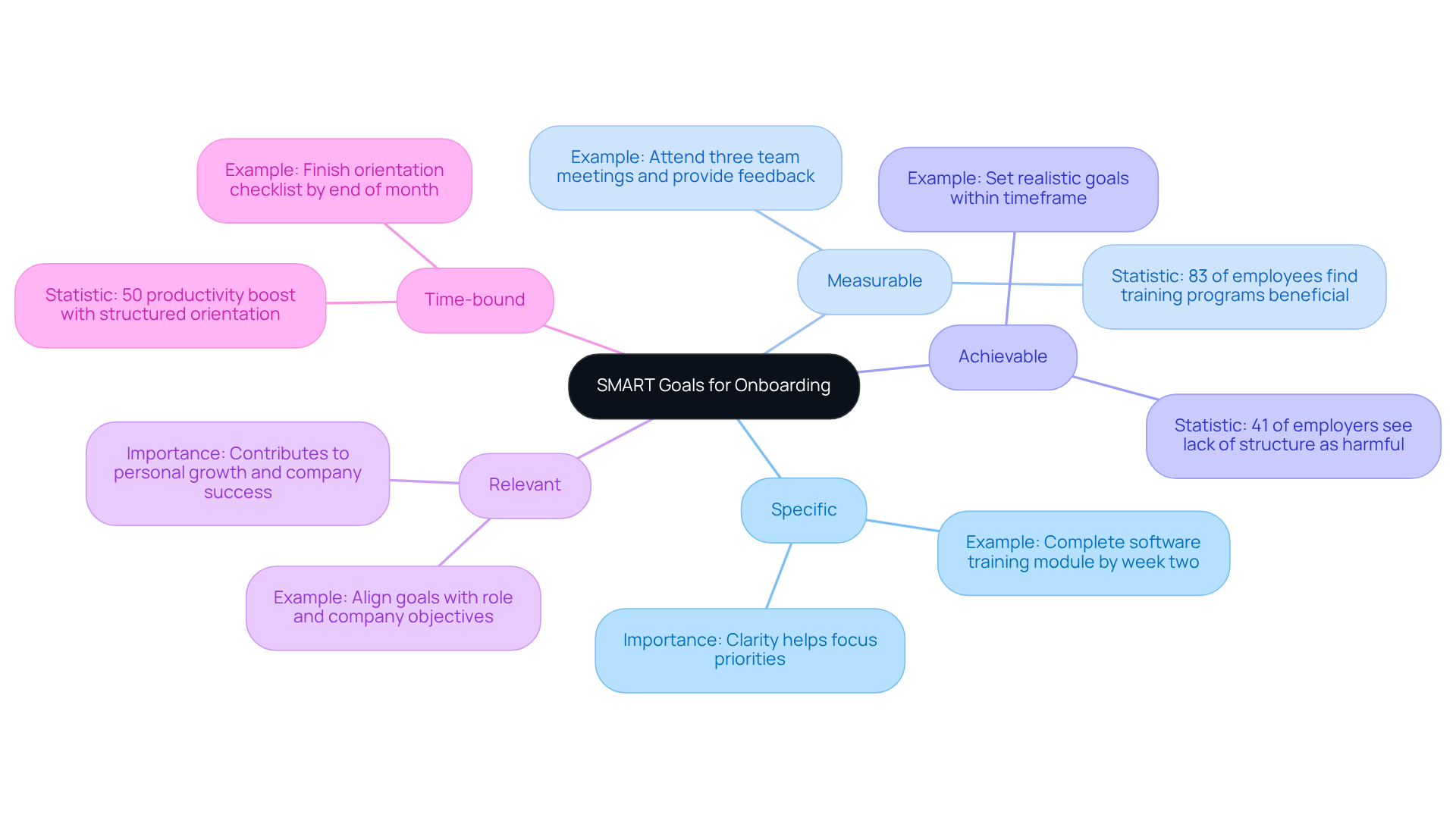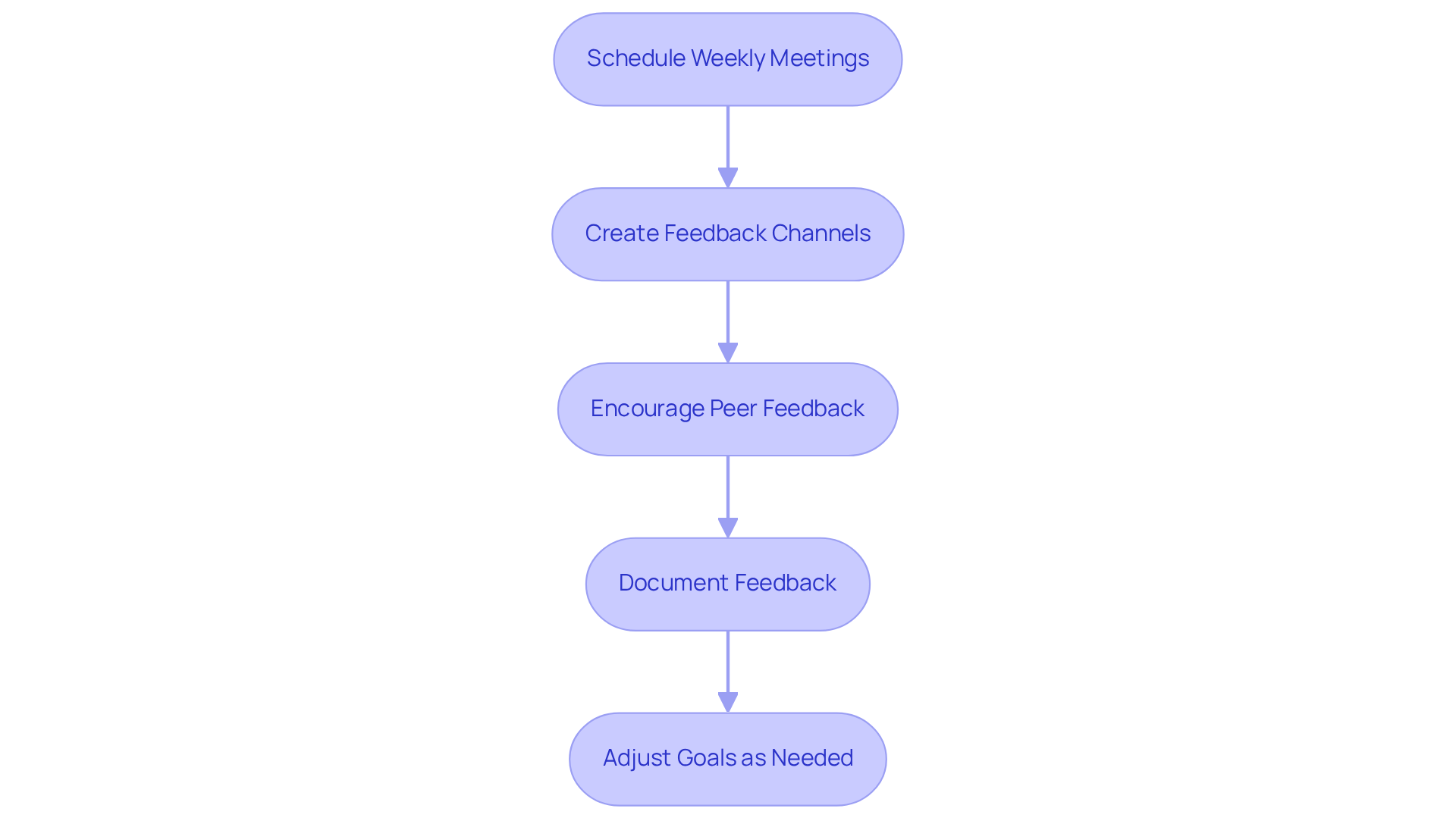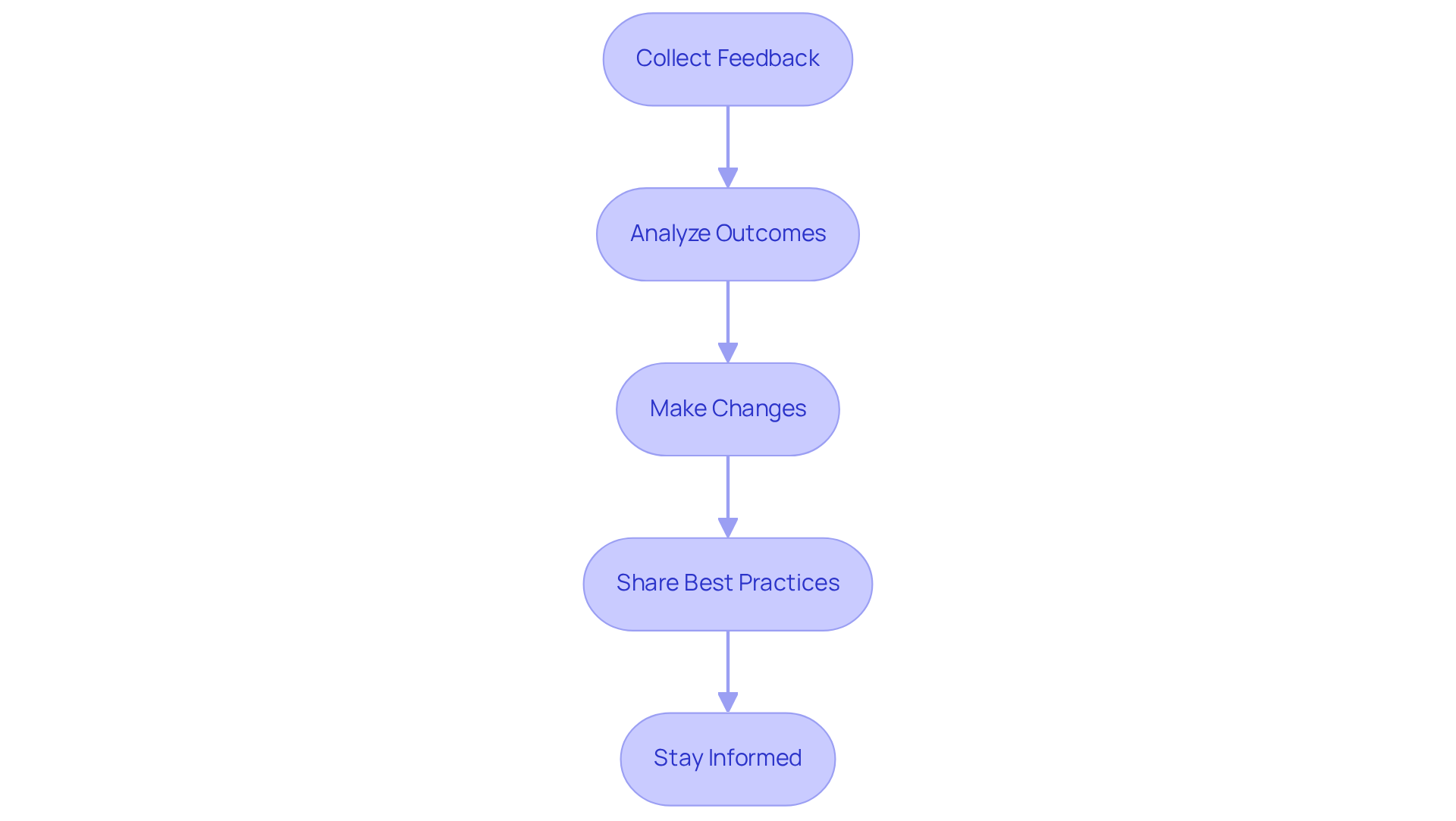
Streamlined Onboarding Processes
|
October 17, 2025
|
Master the 30 60 90 Onboarding Plan for Effective Team Integration
Overview
You might be wondering how to make the onboarding process smoother for new employees. Well, the 30-60-90 onboarding plan is a fantastic way to do just that! It breaks down the onboarding journey into three easy phases:
- Getting to know the company culture
- Building those all-important relationships
- Stepping up to take charge of responsibilities
Each phase comes with its own set of goals, making it super clear what needs to be achieved.
Now, here’s something interesting: organizations that implement structured onboarding systems like this often see much higher retention rates. That’s right! Improved employee satisfaction and better overall performance are just a couple of the perks. So, if you’re looking to enhance your onboarding strategy, it’s clear that having a well-defined plan can make all the difference. Let’s dive into how you can get started with this approach!
Key Highlights:
- The 30-60-90 onboarding plan consists of three phases: learning company culture in the first 30 days, building relationships and contributing in the next 30 days, and taking charge of responsibilities in the final 30 days.
- Structured onboarding systems can lead to a 50% higher retention rate among new employees.
- 48% of HR professionals believe employee integration should take at least three months, emphasising the need for a thorough onboarding strategy.
- 70% of new employees decide if the job is a good fit within their first month, highlighting the importance of a positive onboarding experience.
- Developing a successful onboarding plan involves defining objectives, segmenting the timeline, identifying stakeholders, creating resources, setting milestones, and communicating the plan effectively.
- Setting SMART goals (Specific, Measurable, Achievable, Relevant, Time-bound) enhances the onboarding process and improves retention rates.
- Regular cheque-ins and feedback mechanisms, such as weekly meetings and anonymous surveys, are crucial for fostering a supportive onboarding environment.
- Continuous improvement of the onboarding plan can be achieved through collecting feedback, analysing outcomes, making necessary changes, sharing best practises, and staying informed about industry trends.
Introduction
You might be wondering how the integration of new employees can sometimes feel like navigating uncharted waters, right? It’s a challenge for both the newcomers and the organizations welcoming them.
Enter the 30-60-90 onboarding plan, which acts like a strategic beacon, guiding this transition through structured phases that focus on:
- Learning
- Building relationships
- Taking ownership
By embracing this comprehensive framework, organizations can boost employee satisfaction and retention while aligning new hires with their goals from day one.
But what happens when onboarding is overlooked or poorly executed? The consequences can be pretty serious, leading to disengagement and high turnover rates.
So, let’s dive into the intricacies of the 30-60-90 onboarding plan and uncover how to master its implementation for effective team integration.
Understand the 30-60-90 Day Onboarding Plan
You might be wondering how a 30 60 90 onboarding plan can truly impact the experience of new employees. Well, this strategic framework outlines the onboarding experience in three clear phases, as defined by the 30 60 90 onboarding plan.
- In the first 30 days, it’s all about learning and getting to know the company culture. This helps newcomers settle in comfortably.
- Then, during the next 30 days, the focus shifts to building relationships and starting to contribute to team goals.
- Finally, in the last 30 days, new employees are encouraged to take charge of their responsibilities and drive results.
This structured approach, known as the 30 60 90 onboarding plan, not only makes the transition smoother for new hires but also provides managers with a clear roadmap to guide their integration. Each phase of the 30 60 90 onboarding plan includes specific goals and milestones that align with the organization’s objectives, ensuring that everyone benefits. Did you know that organizations with structured onboarding systems see a whopping 50% higher retention rate among new employees? That really highlights how crucial effective training is for fostering long-term employee relationships.
Moreover, around 48% of HR professionals believe that integrating new employees should take at least three months. This just goes to show how important it is to have a thorough strategy in place. And let’s not forget, a well-structured induction process can significantly boost employee satisfaction and retention. In fact, about 70% of new employees decide within their first month whether the job is the right fit for them. That’s why making a positive impression from the get-go is so vital.
Companies that invest in comprehensive orientation programs often see substantial improvements in employee engagement and productivity, which ultimately leads to better organizational performance. Plus, using induction software can simplify these processes, ensuring that new hires have access to essential resources and support right from day one. And don’t overlook the importance of regularly reviewing and updating orientation materials to keep them relevant and effective. Now, let’s dive into how you can implement these strategies in your organization!

Outline the Steps to Create Your Onboarding Plan
Developing a successful orientation strategy involves several key steps to ensure new employees feel right at home in the organization. You might be wondering how to effectively structure your 30 60 90 onboarding plan. Let’s break it down:
- Define Objectives: First things first, let’s clearly outline what you expect the new employee to achieve in their first 90 days. This could mean mastering certain skills, completing essential training modules, or seamlessly fitting into the team culture. Did you know that having a clear strategy for professional growth makes employees 3.5 times more likely to rate their integration process as exceptional?
- Segment the Timeline: Next, divide that 90-day integration period into three distinct phases. The 30 60 90 onboarding plan should outline that the first 30 days focus on orientation and foundational learning, the next 30 days emphasize relationship building and initial contributions, and the final 30 days encourage the new hire to take ownership of projects and responsibilities. Companies with organized orientation programs see 50% greater employee retention—talk about a game changer!
- Identify Key Stakeholders: Now, let’s think about who will be involved in this integration process. This includes mentors, team members, and managers who can provide guidance and support throughout the new employee's journey. Engaging these stakeholders can really enhance the onboarding experience.
- Develop Resources: It’s also crucial to create resources that will help the new employee transition smoothly. Think training materials, company policies, and process documentation that outline workflows and expectations. With SowFlow's instant documentation solution, your team can quickly access the right documents, ensuring new hires have the necessary information at their fingertips. Effective integration involves role-specific training, introductions to coworkers, and ongoing support.
- Set Milestones: Establish specific milestones for each stage of the integration. These milestones will help monitor progress and ensure accountability, allowing both the new employee and the organization to assess success. Organized initiation procedures boost motivation and productivity, making milestone tracking essential.
- Communicate the Plan: Lastly, share the integration plan with the new hire and all relevant stakeholders. Clear communication aligns everyone on expectations and goals, creating a supportive environment from day one. Plus, gathering feedback on the induction process can provide valuable insights for continuous improvement.
By applying these best practices, along with SowFlow's documentation features, you can create a 30 60 90 onboarding plan that significantly improves the onboarding process, leading to higher job satisfaction and retention. Research suggests that organized orientation programs can enhance employee retention by as much as 82%. That’s a worthwhile investment for any organization looking to cultivate a productive workforce. However, it’s worth noting that 36% of employers still lack a structured orientation process, which can lead to challenges in integration and retention.

Establish SMART Goals and Expectations
To set SMART goals for your onboarding plan, let’s break it down with some friendly guidelines:
- Specific: You want to be clear about what your new employee should achieve. Instead of saying 'learn the software,' how about 'complete the software training module by the end of week two'? This kind of clarity really helps new hires focus on their immediate priorities.
- Measurable: Make sure your goals can be quantified. For instance, 'attend three team meetings and provide feedback on each' not only tracks progress but also boosts engagement. And guess what? Studies show that 83% of employees believe having a training program is a big plus.
- Achievable: It’s important to set realistic goals that your new hire can actually reach within the set timeframe. You don’t want to overwhelm them with impossible expectations. Remember, 41% of employers admit that a lack of structured orientation can hurt their organization.
- Relevant: Align those goals with the new hire's role and your organization’s objectives. This way, their goals contribute to both personal growth and the company’s success, giving them a sense of purpose right from the start.
- Time-bound: Don’t forget to add deadlines to each goal! This creates a sense of urgency and accountability. For example, saying 'finish the orientation checklist by the end of the first month' helps keep everyone focused. Plus, organizations with structured orientation systems see a 50% boost in productivity, which really highlights how important it is to set those timely goals.
By following these SMART criteria, operations managers can effectively enhance the 30 60 90 onboarding plan, leading to better retention rates and happier employees. It’s surprising, but only 12% of U.S. employees feel their organization has a solid orientation process. That’s why organized induction practices are crucial! And here’s a fun fact: Grace Lau points out that 60% of companies don’t set any goals or milestones for new hires. This just shows how vital measurable objectives are during orientation. Effective onboarding can ramp up engagement by a whopping 54%, so it’s essential for organizations to embrace these guidelines. Plus, using [SowFlow's instant documentation solutions](https://sowflow.io) can make the integration phase a breeze, allowing for easy updates and knowledge sharing that boosts overall team efficiency.

Implement Regular Check-Ins and Feedback Mechanisms
To effectively implement regular check-ins and feedback mechanisms during the 30 60 90 onboarding plan, you might be wondering where to start. Here are some friendly steps to consider:
- Schedule Weekly Meetings: Think about establishing weekly one-on-one meetings between the new employee and their manager. These sessions should focus on discussing progress, addressing concerns, and providing guidance. It’s crucial for fostering a supportive environment, don’t you think?
- Create Feedback Channels: How about developing multiple avenues for feedback? Options like anonymous surveys or suggestion boxes can really encourage open communication. This way, new hires can express their thoughts without hesitation, making their integration into the team smoother.
- Encourage Peer Feedback: You know, cultivating a culture where team members can offer constructive feedback to one another is a game changer. Not only does it enhance collaboration, but it also creates a supportive network that can significantly improve the integration experience. Research shows that employees with favorable induction experiences are 10 times more likely to remain with the company, which really highlights the significance of peer feedback.
- Document Feedback: Let’s not forget about maintaining a record of feedback discussions! This helps track progress and identify areas for improvement over time. Plus, it’s crucial for assessing the efficiency of the induction procedure and making any necessary modifications.
- Adjust Goals as Needed: Being adaptable is key! Modify goals based on feedback and the new hire's evolving needs. This adaptability ensures that the integration experience stays relevant and beneficial, ultimately leading to increased retention rates and employee satisfaction.
Now, here’s something interesting: research indicates that organizations implementing a 30 60 90 onboarding plan experience a 50% increase in productivity. That really underscores the importance of these mechanisms in achieving successful integration. And as Grace Lau notes, "Employees who have positive experiences in their first 90 days at a company are 10 times more likely to stay," which emphasizes the critical role of regular check-ins and feedback in fostering long-term employee engagement. Furthermore, considering that 37.4% of HR professionals view remote integration as a significant challenge, applying these practices can help tackle those difficulties effectively.

Review and Adapt the Onboarding Plan for Continuous Improvement
To keep your onboarding plan effective and always improving, let’s think about a few steps you can take:
- Collect Feedback: After each introduction cycle, why not gather insights from new hires and their managers? This feedback is super important for spotting strengths and areas that might need a little boost. Did you know that 89% of employees report feeling more engaged after a successful orientation?
- Analyze Outcomes: Next up, take a look at how your integration process is doing. Check out retention rates, performance metrics, and those employee satisfaction surveys. Organizations that have a structured orientation see a whopping 60% year-on-year improvement in revenue. That really shows how crucial thorough analysis can be!
- Make Changes: Now, let’s talk about making adjustments. Utilize the feedback and analysis to adjust your 30 60 90 onboarding plan. Companies that invest in solid orientation frameworks can slash employee turnover by up to 82%. That’s a huge win for customized orientation experiences!
- Share Best Practices: Don’t forget to document those successful strategies and share them with your team. This helps create a culture of continuous improvement and ensures that effective practices are shared all around the organization.
- Stay Informed: Lastly, keep an eye on industry trends and best practices in employee integration. With 41% of HR professionals expecting to see more automated onboarding processes, staying informed will help you keep your onboarding process fresh and effective.
So, what do you think? Ready to take your onboarding to the next level?

Conclusion
You might be wondering how a 30 60 90 onboarding plan can really make a difference in welcoming new employees. Well, it’s a fantastic tool that helps integrate them into your organization smoothly! By breaking the onboarding process into three easy phases—learning, relationship building, and taking ownership—this structured approach not only helps new hires transition but also aligns their goals with what your organization aims to achieve. When you emphasize a strategic onboarding framework, you’re likely to see happier employees who stick around longer, which is a win for everyone!
Throughout the article, we’ve highlighted some key insights that show just how important it is to:
- Set clear objectives
- Establish SMART goals
- Have regular check-ins to create a supportive onboarding experience
Engaging stakeholders, developing essential resources, and keeping those feedback channels open are steps that really enhance the integration process. Plus, adapting your onboarding plan based on feedback ensures it stays relevant and effective for both new hires and your organization.
So, here’s the deal: organizations that make a solid 30 60 90 onboarding plan a priority not only boost employee engagement and productivity but also significantly cut down turnover rates. Investing in comprehensive onboarding strategies is key to fostering a vibrant workplace culture. By embracing these best practices, you can create a welcoming environment that empowers new employees to hit the ground running and make meaningful contributions from day one. Now, let’s get to work on implementing these strategies and see the amazing impact they can have on team integration and overall performance!
Frequently Asked Questions
What is the 30-60-90 day onboarding plan?
The 30-60-90 day onboarding plan is a strategic framework that outlines the onboarding experience in three phases: the first 30 days focus on learning and understanding company culture, the next 30 days emphasize building relationships and contributing to team goals, and the final 30 days encourage new employees to take charge of their responsibilities and drive results.
Why is the 30-60-90 day onboarding plan important?
This plan helps make the transition for new hires smoother and provides managers with a clear roadmap for guiding their integration. Structured onboarding can lead to a 50% higher retention rate among new employees and significantly boost employee satisfaction and productivity.
What are the key steps to create a successful onboarding plan?
Key steps include defining objectives for the new employee, segmenting the timeline into the three phases of the onboarding plan, identifying key stakeholders for support, developing necessary resources, setting specific milestones for each stage, and communicating the plan clearly to all involved.
How can organizations improve employee retention through onboarding?
Organizations with structured onboarding programs see improved retention rates, with research suggesting that organized orientation can enhance retention by as much as 82%. Additionally, having a clear strategy for professional growth can make employees 3.5 times more likely to rate their integration process as exceptional.
What role do stakeholders play in the onboarding process?
Stakeholders, including mentors, team members, and managers, are crucial for providing guidance and support throughout the new employee's journey, enhancing the overall onboarding experience.
What resources should be developed for new employees?
Resources should include training materials, company policies, process documentation, and role-specific training to ensure new hires have the necessary information and support to transition smoothly into their roles.
How can organizations track the progress of new employees during onboarding?
Organizations can set specific milestones for each stage of the onboarding process, which helps monitor progress and ensures accountability for both the new employee and the organization.
What is the impact of effective onboarding on employee engagement and productivity?
Companies that invest in comprehensive orientation programs often see substantial improvements in employee engagement and productivity, leading to better overall organizational performance.
👍
What others are liking
5 Steps to outline your ideal documentation structure
5 MINS READ
Where to start the your journey of mapping out your ideal documentation structure, aligning it with the very heartbeat of your organization?
Defining a winning level of detail in your process
3 MINS READ
What is too much detail, and what is too little? This article described in that winning level detail about what detail is enough.





